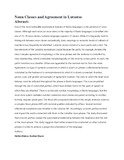Noun Classes and Agreement in Lutsotso
Abstract
One of the most noticeable grammatical features of Bantu languages, is the presence of noun classes. Although each noun (or noun stem) in the majority of Bantu languages is classified into one of 15–18 noun classes, Lutsotso language captures 21 classes. While it is frequently hard to distinguish between noun classes semantically, basic meanings or semantic trends of subsets of members may frequently be identified. Lutsotso nouns consist of a noun prefix and a root. The two elements of the Lutsotso nominal are crucial because the prefix, for example, denotes the class. Complex agreement morphology in the noun phrase and the sentence is controlled by class membership, which is indicated morphologically on the noun by a class prefix. As such, the prefix functions as a classifier. Affixes are appended to the nominal root to form the noun. Agreement is a type of syntactic connection in which a word's or phrase's inflectional behaviour is dictated by the features of a nominal element to which it is closely connected. Number, person, case, and gender are examples of agreement markers. The class to which the head noun belongs must be reflected throughout the phrase in Bantu languages. This is accomplished through the use of concordial prefixes, which have distinct forms for the parts of speech to which they are attached. There is no discrete number morphology in Bantu languages, but the noun class system mediates number; numerous noun classes are paired according to number, forming singular-plural pairs. The Noun (N) component element of the simple sentence exists as a complex Noun phrase (NP) with nominal qualities indicated by affixes. Several nominal inflectional morphemes are included in the Lutsotso NP. Accordingly, concord prefixes control and impact the words connected with them in the Lutsotso noun phrase. The study discovered that concord prefixes sustain the grammatical relationship between the headnoun and the rest of the noun phrase. This study suggests that further research be conducted on other Lutsotso phrases in order to achieve a proper documentation of this language.
URI
https://doi.org/10.58256/njhs.v7i1.999https://royalliteglobal.com/njhs/article/view/999
http://ir-library.mmust.ac.ke:8080/xmlui/handle/123456789/2202
Collections
- Journal Articles [411]

